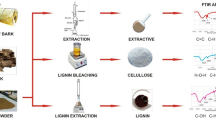Abstract
Cellulose trifluoroacetate (CTFA) with DS values of 1.5 and 2.1 and DP values ranging from 170 to 800 have been prepared free from impurities of the reaction mixture (weakly bound trifluoroacetic acid) and of the procedure of isolation (diethyl ether). The CTFAs are soluble in DMSO, DMF, pyridine, and THF and thermostable up to 250 °C. A convenient synthetic method for CTFAs with DS 1.5 involves the acylation of cellulose with mixtures of trifluoroacetic acid (TFA) and trifluoroacetic anhydride (TFAA, 33% v/v) at room temperature for 4 h and subsequent treatment of the crude polymer at 150 °C and 80 Pa for 40 min. The preparation of CTFAs with DS-values up to 2.1 requires the addition of chloroform and 16 h reaction time.13 C-NMR studies as well as HPLC analyses after methylation and chain degradation show a preferred trifluoroacetylation of the primary hydroxy groups of the cellulose. The extent of depolymerization during the trifluoroacetylation was investigated for various cellulose materials. The cleavage of the trifluoroacetyl groups is possible by treating the derivative with a protic medium like water. Total hydrolysis of CTFA dissolved in DMF with water (room temperature) takes 6 min.
Similar content being viewed by others
References
Cemeris, M., Mus'ko, N.P. and Cemeris, N. (1951)Khim. Drev. 2, 29–33.
Doering, H. (1951)Das Papier 23/24, 507–512.
Emel'yanov, Yu. G., Grinshpan, D. D. and Kaputskii, F. N. (1988)Khim. Drev. 1, 23–28.
Erler, U., Mischnick, P., Stein, A. and Klemm, D. (1993)Polymer Bull. 29, 349–356.
Fengel, D. and Stoll, M. (1989)Das Papier 43, 653–657.
Fujimoto, T., Takahashi, S.-I., Tsuji, M., Miyamoto, T. and Inagaki, H. (1986)J. Polym. Sci. Part C,Polym. Lett 24, 495–501.
Geddes, A. L. (1956)J. Polym. Sci. 22, 31–39.
Hasegawa, M., Isogai, A., Onabe, F. and Usuda, M. (1992)J. Appl. Polym. Sci. 45, 1857–1863.
Klemm, D., Schnabelrauch, M., Stein, A., Heinze, T., Erler, U. and Vogt, S. (1991)Das Papier 12, 773–778.
Klenkova, N. L., Buldova, O. S., Matveeva, N. A. and Volkova, L. A. (1982)Cellul. Chem. Technol. 16, 615–629.
Kriszenbaum, M., Corset, J. and Josien, M. L. (1971)J. Phys. Chem. 75, 1327–1330.
Mohdy, F. A. A., Khalil, M. J. and Hebeish, A. (1983)Cell. Chem. Tech. 17, 559–573.
Mark, H. F., Bikales, N. M., Overberger, C. G. and Menges, G. (1985) InEncyclopedia of Polymer Science and Engineering, Vol. 3, New York: John Wiley, pp. 158–226.
Milne, J. (1975) InThe Chemistry of Nonaqueous Solvents,VB, (J. J. Lagowski, ed.) New York: Academic Press.
Patel, D. L. and Gilbert, R. D. (1981)J. Polym. Sci. Phys. Ed. 19, 1231–1236.
Philipp, B. (1990)Polymer News 15, 170–175.
Reeves, L. W. (1961)Can. J. Chem. 39, 1711–1720.
Schaub, M., Wenz, G., Wegner, G., Stein, A. and Klemm, D. (1993)Adv. Mater. 919–922.
Schnabelrauch, M., Heinze, T. and Klemm, D. (1990)Acta Polymerica 41, 112–120.
Schnabelrauch, M., Vogt, S. Klemm, D., Nehls, I. and Philipp, B. (1992)Angew. Mak. Chem. 198, 155–164.
Shimizu, Y. and Hayashi, J. (1989)Cell. Chem. Tech. 23, 661–670.
Valtsaar, H. and Dunlap, R. (1952) In Abstracts of papers, 122nd National Meeting of the American Chemical Society, abstract 3D.
Yalpani, M. (1985)Tetrahedron 41, 2957–3020.
Author information
Authors and Affiliations
Additional information
The first paper on this topic was concerned with cellulose formates (Schnabelrauchet al., 1992).
Rights and permissions
About this article
Cite this article
Liebert, T., Schnabelrauch, M., Klemm, D. et al. Readily hydrolysable cellulose esters as intermediates for the regioselective derivatization of cellulose; II. Soluble, highly substituted cellulose trifluoroacetates. Cellulose 1, 249–258 (1994). https://doi.org/10.1007/BF00812508
Issue Date:
DOI: https://doi.org/10.1007/BF00812508




